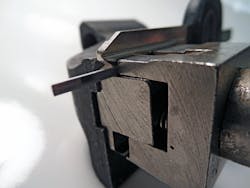Key cutting machines depend on a relationship between the bottom of the vise jaw and the position of the cutter blade. When key duplicating machines were first invented, most of the keys were single-sided. The flat bottom of the key blade was set against the vise jaw and the key blade was easily secured in a level position. Special holders were sometimes made for the few available double-sided key blanks such as a Chicago CG1 or later for the Ford five-cut keys.
An invasion of foreign vehicles in the 1970s introduced U.S. locksmiths to a wave of double-sided key blanks. It took most domestic car makers several years to catch up, but the ease of being able to insert the key without concern for orientation finally won the day. Chrysler began the double-sided key changeover in 1989 and GM later followed in 1994. The last single-sided vehicle key holdout is the domestic big truck industry, but they also are finally in the process of changing to double-sided keys.
When duplicating or originating the first side of a double-sided key, the uncut reverse side can still act as a flat surface to align the key parallel with the vise jaw. Cutting problems occur when cutting the second side. Key machine manufacturers have developed four-way jaws for their duplicating machines. As long as both the original key and the duplicate are held at the same height by identical jaws, exact duplication is not an issue. Originating keys on a code machine is where the problems begin.
A large percentage of locksmiths depend on manual code machines. Card-operated code machines such as the Ilco Universal II or the Framon 2 use a set of vise jaws with parallel sides to clamp the key blank into position. Vise jaws only clamp onto the key blade in order to bypass any possible rubber headed key bows. One or two key machine manufacturers have devised expensive optional jaw systems or special individual key holders in an effort to solve the problems related to cutting the second side of a double-sided key.
Most double-sided key blanks have several things in common. First, the blade area for key cutting is usually a flat area. Second, key cut depth possibilities usually extend from the top of the uncut blade to the beginning of the thicker middle section of the key blank. As example: The #1 cut for a B86 GM key blank is .315 which is the uncut, full width of the key blank. A #4 cut for a B86 blank is .240, which is very close to the thick portion of the key blank. The difference between .315 and .240 is .075.
If a shim of approximately .075 thickness is inserted against the B86 key blank, the key can be easily set and held parallel in the vise jaw while cutting either the first or second side of a double-sided key blank. Shim stock widths of .060" and .075" will cover almost every popular double-sided key blank size.
Rectangular stock would make ideal shims but the required sizes could not be found. The next best substitute was cotter pins. An easy, economical solution for holding double-sided keys in a key machine involves an investment in cotter pins and a half hour of time. A kit from Harbor Freight which contains over 500 cotter pins was purchased for approximately $5. Cotter pins of 3/32" size were used. 3/32" cotter pins measure approximately .075 inches from side to side.
Smaller sized, .060 cotter pin shims must be made from the 3/32" size. A nail can be used to hold the cotter pin in a vise while filing each side until the .060 thickness is reached. When sizing is complete, cut off the loop with a wire cutter and you have two half-round shims. Each individual shim costs a penny and you still have over 200 cotter pins which can be used for their intended purpose.
The vice photo shows the cotter pin shim in action. Half-round shims can also be used to support some single-sided keys such as an EZ Y1 blank during duplication or originating.
About the Author

